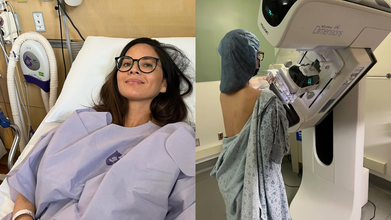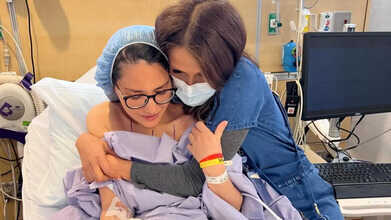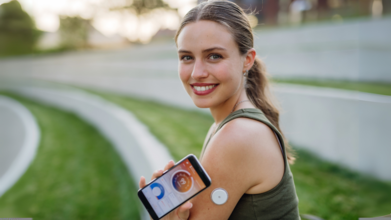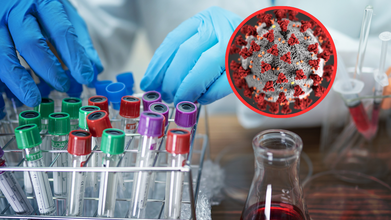- Health Conditions A-Z
- Health & Wellness
- Nutrition
- Fitness
- Health News
- Ayurveda
- Videos
- Medicine A-Z
- Parenting
- Web Stories
Olivia Munn Breast Cancer Lifetime Risk Assessment Test 2025, Details Inside

(Credit - Oliviamunn/Instagram)
Actress Olivia Munn shared an intimate video from May 2023, just before she had a double mastectomy for breast cancer. The video, posted on Instagram for World Breast Cancer Research Day, shows Munn in her hospital bed with her husband, John Mulaney. He is sitting beside her, holding her hands. They press their foreheads together and speak in hushed tones, surrounded by the quiet sounds of the hospital.
Munn wrote in her caption that this was her first of five surgeries in her "determined battle to beat breast cancer."
One of the biggest aspects of her treatment was the “lifetime risk assessment test” she mentioned in her caption. “Please go to the link in bio to take the quick and free lifetime risk assessment test that saved my life.”

What Is Lifetime Risk Assessment Test?
According to the MagView Tyrer-Cuzick Risk Assessment Calculator* in Munn’s bio, this test helps one calculate their lifetime risk of developing breast cancer. The tool urges people to reach out to their healthcare professional in case they have any questions about their risk of developing breast cancer and what are the best options for breast cancer screenings or genetic counseling they may have.
The US National Cancer Institute also has an Breast Cancer Risk Assessment Tool (BCRAT) known as Gail Model, which helps healthcare professionals estimate a woman’s risk of developing invasive breast cancer over the next five year. The tool uses a person’s medical history as well as breast cancer history among the first-degree relatives to estimate theur risk of getting breast cancer
Olivia Munn’s Breast Cancer Journey
In her post caption, Munn details how she has gone through a double mastectomy, reconstruction surgery, a lymph node dissection, and a hysterectomy. She recently shared that her mother also received a breast cancer diagnosis two years after her own.
Munn explained that both her and her mother's cancer are "very aggressive, fast-moving." However, she added that thanks to research funding, they both had a path to survival. For example, she said that endocrine therapy, a hormone treatment she is currently on, was discovered just 20 years ago. This treatment works by keeping hormones from reaching cancer cells.
Also Read: World Mosquito Day 2025: Dengue Transmission Isn’t One-Way, Humans Infect Mosquitoes Too
Olivia Munn’s Message for Early Detection of Breast Cancer
Munn emphasized that funding for breast cancer research has created treatment plans that give her and many others hope. She urged her followers to donate, saying that their contributions could save countless lives by helping to find cures and improve treatments. She also recommended supporting organizations like Susan G. Komen and the American Cancer Society, which have made a real impact.
In her post, Munn also encouraged women to take the breast cancer assessment test. She discovered she had a 37% chance of breast cancer, which led to more tests that found her aggressive form of the disease. She stressed that any woman over 30 should take the test, and if their risk is above 20%, they should ask their doctor for a breast MRI.
Who Should Get Breast Cancer Screening Done?
According to the American Cancer Society, you are considered to be at average risk if you do not have a personal history of breast cancer, a strong family history of it, or a known genetic mutation (like in the BRCA gene) that increases your risk. This also applies if you have not had chest radiation before the age of 30. These are the breast cancer screening recommendations for women who are average risk.
Ages 40-44: You have the choice to start getting a mammogram every year.
Ages 45-54: You should get a mammogram every year.
Ages 55 and older: You can switch to getting a mammogram every other year, or you can choose to continue getting one every year. You should continue to get screened as long as you are in good health and are expected to live at least 10 more years.
Keep in mind that these guidelines are for mammograms only. Clinical breast exams, which are physical exams done by a doctor or other healthcare professional, are not recommended for breast cancer screening in women at average risk.
*Please Note: The Magview Tyrer-Cuzick Risk Assessment Calculator is for non-commercial and non-clinical use, for a clinical diagnosis, please reach out to your healthcare professional.
FDA Approves First Glucose Monitoring System For Weight Loss, But Should People Who Don’t Have Diabetes Wear It?

Credits: Canva
The Food and Drug Administration just approved the first-ever glucose monitoring system specifically for weight loss, establishing a new option for Americans to manage their weight. Until now, the main options have been expensive obesity drugs like Wegovy and Zepbound or surgical interventions both usually limited to people with a certain BMI. Even then, access is tough: high price tags, patchy insurance coverage, and limited supply often put these treatments out of reach.
Could a wearable device that tracks your body’s glucose in real time open up a more accessible, personalized way to manage weight? This approval suggests the answer might finally be yes.
Continuous glucose monitors (CGMs) were designed as lifesaving devices for people living with diabetes. They eliminate the need for constant finger-prick tests, instead offering near real-time blood sugar readings through a small wearable sensor. For individuals managing type 1 diabetes, type 2 diabetes on insulin, or gestational diabetes, this technology has transformed daily life—improving safety, flexibility, and long-term health outcomes.
But lately, CGMs are appearing on the arms of people who don’t have diabetes. Celebrities, elite athletes, and wellness influencers are adopting these devices in the name of performance, longevity, or “biohacking.” While the movement reflects a growing cultural obsession with data-driven health, experts are increasingly asking: is this medical technology being used responsibly—or is it being misapplied in ways that provide more confusion than clarity?
What Is Glucose?
To understand the debate, it helps to revisit the basics. Glucose is the body’s main source of energy, fueling muscle, brain, and organ function. Think of it like gasoline for a car: too little, and the system stalls; too much, and long-term damage builds up.
In healthy individuals, the body keeps glucose within a safe range by releasing insulin, a hormone made in the pancreas that helps shuttle glucose from the bloodstream into cells. For those with diabetes, this regulatory system is impaired, which makes constant monitoring critical.
Even without diabetes, blood sugar naturally fluctuates throughout the day depending on meals, physical activity, stress, illness, or even puberty. These swings are normal. What’s not normal is chronic dysregulation—something CGMs were designed to help patients detect and manage.
How Continuous Glucose Monitors Work?
Traditionally, people with diabetes relied on finger-prick testing several times a day. CGMs replaced much of that burden. A small sensor, often worn on the arm or abdomen, measures glucose levels in the fluid between cells every few minutes. The data is sent to a reader or smartphone app, allowing patients to track trends, prevent dangerous highs or lows, and adjust treatment accordingly.
For someone with type 1 diabetes, this technology can be the difference between life and death. It allows immediate action when glucose drops during sleep or spikes after meals. For pregnant women with gestational diabetes or people with type 2 diabetes on insulin, CGMs have also been shown to improve outcomes and reduce complications.
How Does A Wellness Tracker Work Without Diabetes?
Now, CGMs are crossing over into the wellness market. High-profile users—from tech CEOs to pro athletes—praise the devices for giving insights into how food, exercise, and stress affect their glucose patterns. Apps connected to CGMs often promise personalized nutrition advice or “metabolic optimization.”
There is some appeal: glucose spikes after eating highly processed carbohydrates or sugary foods can leave anyone feeling sluggish, and seeing that spike in real time can reinforce healthier food choices. For endurance athletes, monitoring glucose may help optimize fueling strategies during long events.
But the scientific evidence in support of CGM use among healthy individuals is lean. A 2022 study published by the University of the Sunshine Coast concluded that CGMs offered little clinically significant benefit for non-diabetic athletes. More recently, scientists examining international data in 2024 cautioned that promotional suggestions for CGM use in healthy populations might be "misleading," considering how little proven outcomes exist.
Is There Any Potential Downsides of Over-Monitoring
There's a second danger, information overload. For individuals who don't require vigilant watching, the data stream can cause worry or even unhealthy preoccupation. Every rise in blood sugar doesn't need a response—though some users might feel obligated to "correct" every spike, perhaps ending up on a restricting diet or feeling unduly anxious.
Its economic burden is also important. A CGM sensor with a life of just 14 days can be over $100 if it is not covered by insurance or public subsidies in the United States.For individuals without diabetes, that’s a steep price for information that may not translate into measurable health benefits.
Part of the fascination comes from the broader movement toward “biohacking” and quantified health. Wearables like smartwatches, sleep trackers, and fitness rings have made people more comfortable tracking biometric data daily. CGMs fit naturally into this landscape, offering a continuous metabolic data stream that feels cutting-edge and personalized.
Add in celebrity influence—musicians, influencers, and athletes openly wearing CGMs in interviews or on social media—and public interest has surged. For some, it represents empowerment: a way to take control of invisible processes in the body. For others, it’s simply the latest wellness trend in a crowded marketplace of supplements, gadgets, and health apps.
It’s worth noting why CGMs appeal to so many people. Nearly 74% of Americans are overweight or obese, according to government data, with obesity-related conditions costing the U.S. healthcare system more than $170 billion annually. With metabolic health under such strain, many are searching for tools to stay ahead of potential problems.
CGMs may feel like a proactive solution but experts caution that prevention is less about constant glucose monitoring and more about proven strategies: balanced nutrition, physical activity, adequate sleep, and routine medical check-ups. For now, CGMs aren’t a shortcut to better health if you don’t already have a condition requiring them.
Should People Without Diabetes Use CGMs?
The answer isn’t black and white. For individuals with diabetes, CGMs are life-changing and medically essential. For those without diabetes, the benefits are mostly speculative, while the risks anxiety, cost, and misuse of data are very real.
Legionnaires' Outbreak Sickened 108 And Kills 5 In New York City: Can It Spread From Person To Person?

(Credit - Canva)
A recent outbreak of Legionnaires’ disease in Central Harlem, a neighborhood in New York City, has led to a number of illnesses and some deaths. So far, five people have died, and over 100 people have been confirmed to be sick.
The city's health department has been tracking the outbreak since it began in late July. They've found that the number of new cases is going down, which suggests their efforts to clean up the source have been working. Still, they are continuing to investigate and monitor the situation.
The outbreak was traced back to cooling towers in the area. Cooling towers are a part of a building's air conditioning system that uses water to help cool it down. The city health department tested all the cooling towers in the affected areas and found that 12 of them had the bacteria. They have all since been cleaned and treated. Health officials have said that the issue is with the cooling towers, not with the regular hot or cold water in the buildings, and that it's safe for people to continue using their air conditioners.
Can It Spread From Person To Person Contact?
Legionnaires' disease is not contagious, so you can't get it from another person. The disease is mainly spread when someone breathes in tiny water droplets (called aerosols) that are contaminated with the Legionella bacteria.
While it's not common, you can also be exposed by breathing in contaminated soil or, in rare cases, by accidentally breathing in water while drinking it.
Whether a person gets sick after exposure depends on a few things: their overall health, how much of the bacteria is in the air they breathe, and how contaminated the source of the bacteria is.
What Caused The Sudden Surge In Numbers?
As of Monday, 14 people were hospitalized according to the health department. However, within the span of 5 days the number of infections has jumped to 108 people. Harlem City Councilmember Yusef Salaam, in a press conference last week urges people to visit the doctor if they exhibit any flu-like symptom to visit the doctor.
"This is the time for you to actually go and seek medical attention. That's how serious this is."
How Long Does It Take For Legionnaires Symptoms To Appear?
Legionnaires’ disease is a serious type of lung infection, or pneumonia. People can get sick by breathing in tiny water droplets that contain the bacteria. The symptoms can take up to two weeks to appear and often feel like a bad case of the flu, including a cough, fever, chills, headaches, and muscle aches. The disease got its name from an outbreak in 1976 among a group of veterans at a convention. While the disease is not very common, it is becoming more of a concern nationwide, with research suggesting that hotter, more humid weather might be a reason for the increase in cases.
Abu Dhabi’s Genetic Screening Programmes For New Borns Could Detect 800+ Diseases

(Credit - Canva)
The Department of Health – Abu Dhabi (DoH) has launched a big initiative to improve healthcare for future generations. Teaming up with the Emirati Genome Council, they've started one of the world's most comprehensive Newborn Genetic Screening Programmes.
Genetic health problems can be difficult to predict and can be passed onto the child, even if the parents did not have symptoms themselves. Many times, these disorders or diseases do not surface until later in life. Here is where genetic screenings and tests come into play. These help us predict any future issues and tackle them head-on.
Instead of treating every patient the same way, this program is designed to deliver a more personal and precise kind of healthcare. It uses advanced genetic technology to look at a person's unique DNA. This allows doctors to catch health conditions much earlier than before, sometimes even before a baby is born.
By finding these issues so early, doctors can provide special, tailored treatments. This means the care a child receives is not a generic plan, but one created specifically for their needs. This approach leads to better results because it gets to the root of the problem right away.
What Is Genetic Screening?
According to National Human Genome Research Institute (NHGRI) It is a process that look at a large group of people to find a smaller group who might be at higher risk for a specific genetic disease. This higher-risk group might either have the disease themselves, be at risk of developing it later, or have a chance of passing it on to their children.
Can We Predict Health Problems?
This program screens for over 815 treatable childhood genetic conditions by looking at a baby's entire genetic makeup, called whole genome sequencing. This makes it one of the most thorough programs of its kind. It's already started at Kanad Hospital and Danat Al Emarat Hospital, where they use advanced technology and Artificial Intelligence (AI) to find conditions that might not be obvious at birth but could become a serious problem later.
The plan is to eventually screen all children of UAE nationals and Emirati mothers born in Abu Dhabi. This is done by collecting a small cord blood sample at birth with the parents' permission. The screening looks for many different issues, including problems with a baby's metabolism, immune system, blood, and rare diseases like Spinal Muscular Atrophy, which can now be treated.
Can Genetic Screening Lead Us Towards Healthy Future?
Parents will get the results within 21 days. If the screening finds anything concerning, a counselor will meet with the family to explain the findings and connect them with specialists for further care.
To make sure the program is a success, the DoH has worked closely with experts. They've held workshops to prepare everyone involved. They also trained 16 pediatricians and neonatologists from Corniche Hospital, Danat Al Emarat, and Kanad Hospital on genetic counseling and why this screening is so important. They also made sure that obstetricians, midwives, nurses, and technical staff at these hospitals were fully prepared.
This program is a key part of Abu Dhabi's bigger goal to use genomics for family health. This includes existing programs like premarital screening. These efforts are all about preventing genetic diseases, helping families make informed decisions, and giving children early access to the care they need. The ultimate aim is to create a healthcare system where personalized, preventative care is the norm, ensuring a healthier future for everyone.
© 2024 Bennett, Coleman & Company Limited

